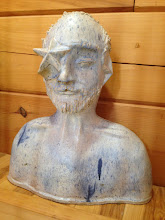The salt went into the kiln starting at about 3:00 AM and we closed the kiln in and went to the house at about 3:45. But that is the end of the story, lets back up a bit...
After having finished bricking in the door at about 10:00 PM the night before, Rob got up and was out to the kiln at about 5:45 AM. Amy and Rob took the first shift and fired through the morning. Jody came about 1:00 PM and was greeting by the other occupants of the farm.

The kiln was already started to breath a little fire.

On the basic level, firing a wood kiln is simple. You pick up a bundle of wood, open the door and put the wood in.

and repeat, and repeat,

and repeat, and repeat, and...

As night closes in and the kiln reaches about 2000 degrees, it becomes a fire breathing dragon.

It was beautiful to see the moon rise over the valley while hearing the roar of the kiln.

While the stoking is easy, but tiring, getting to the right temperature is a little more complex. You need to find a balance between the amount of cool air you let in through the "mouse" holes, the amount of wood you put in, and the amount of hot gases you let up the chimney by adjusting the dampers.

You keep track of it by watching the cone packs via "spy" holes and tracking the temperature with a probe (thermocouple) and a pyrometer. This is a view of the pyrometer.

Below is a plot of the temperature measured versus the time spent. The kiln takes between 20 and 22 hours to reach the desired level of heat. The plot shows that the rise in temperature comes quickly early on, but it really goes slowly towards the end. The rate of stoking and amount of wood added goes way up also during those last 200 to 300 degrees of rise.

However, at some point in the wee hours of the morning, it comes time to add the salt to the kiln. Shown below are views of how the salt is added. The salt used here was a "meat curing" blend obtained from the local Co-Op.

The tool to put it in the kiln is a pipe cut in half. The salt is measured out and poured along the pipe.

With the dampers closed down, the stoke hole is opened up and the pipe inserted over the coal bed. The pipe is then turned over and the salt falls onto the coals. The salt breaks down into its components, sodium and chlorine gas. The gas goes up the chimney and the sodium seeks out the silica in the clay, reacts with it and forms a glaze.

At this point the firing is done. We close up the kiln and go home. We pass by the trailer loaded with the wood to be cut for the next firing. Ugh, lets think about that next week.

Following soon will be the kiln opening...Christmas time for potters!
































